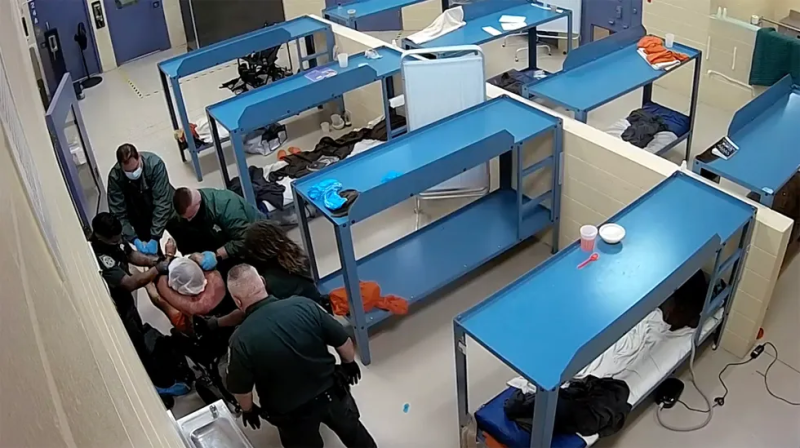Spit hoods can be deadly. Police keep using them anyway.
When Tim Peters started banging on a neighbor’s door and shouting about religion just before sunrise with a beer bottle in his hand, someone called the county sheriff. Neither the deputies nor Peters’ wife, Julie, could get him to calm down.
He ended up in the medical unit at the Hernando County jail north of Tampa in April 2022. Video from his cell showed the 49-year-old handyman struggling with deputies. They pepper sprayed him. Then they covered his face with a mesh bag known as a spit hood. When it became soaked with saliva and blood, they added another one. Minutes later, Peters was motionless in a wheelchair.
Jail staff spent nearly three minutes pumping on his chest to revive him before they took the bags off of his head. He died at a hospital the next day. A medical examiner noted the use of the spit hoods in her report but concluded that the cause of death was undetermined.
“He was my best friend, and I was his,” Julie Peters said. “The person in that video, that was not the Tim I know.”

Spit hoods, also called masks, socks or nets, briefly became part of the national debate about police use of force in 2020, when 41-year-old Daniel Prude suffocated after police in Rochester, New York, forced a hood on him because he claimed to have COVID and spat in their direction.
A few police departments, like the one in Tucson, Arizona, have since stopped using the restraints. But many have not — and the deaths have continued. Police used spit hoods on at least 31 people who died in their custody between 2013 and 2023, according to an investigation by The Marshall Project and WTSP, the CBS affiliate in Tampa.
There are no national reporting requirements on deaths involving spit hoods. And most departments that give patrol officers the masks don’t track how often they are used. Many departments have no policies on deploying the device — and among the ones who do, the rules vary wildly. The Polk County Sheriff’s Office, southwest of Orlando, said it doesn’t have a policy, and that spit hoods “are used when it makes common sense.”
In most of the deaths the news organizations analyzed, medical examiners said they couldn’t determine how people died, or they cited other causes, like drug overdoses. The Marshall Project and WTSP found at least five cases where coroners mentioned spit hoods as a possible cause or contributing factor in fatalities.
“One death is too many,” said George Kirkham, a Florida State University criminology professor who is an expert in police use of force. “We can say more people die from shootings or beatings, but the families of these folks are devastated just the same.”
Mentions of spit hoods in deaths involving police can remain hidden from public view for months or forever. Sheriff’s officials in Florida did not initially tell the public that they placed two hoods on Peters. They revealed it only after WTSP reporters pressed the agency for more details and eventually obtained an unredacted 21-minute video of Peters’ death.
Many police departments include spit hoods in their use of force policies and consider them restraints. But other police chiefs and law enforcement leaders have characterized spit socks as sanitary devices. The hoods keep people from spitting on officers and save them from potential health risks from contact with saliva. In fact, healthcare workers also use the nets to keep patients from spitting on them in places like hospitals, ambulances and nursing homes.
“Proper use (i.e., application, general wearing, and removal) of the spit hood is not, in and of itself, a use of force,” former DC Metropolitan Police Chief Robert Contee wrote about his agency’s spit hood policy in September 2022.
Some research studies have shown that even dense spit hoods are easier to breathe in than an N95 mask, and study subjects could breathe even in hoods sprayed with artificial saliva. But critics say none of those studies mimicked the chaos and stress of being arrested or held in jail.
Still, sheriff’s deputies in Hernando County cited one of those studies, by researchers at the University of California in San Diego, in defending their actions in Peters’ death.
In a press conference last fall, Hernando County Sheriff Al Nienhuis said Peters fought deputies who tried to restrain him, and that they put a second spit sock on Peters because the first one had become wet. Spokesperson Denise Moloney told The Marshall Project she couldn’t comment extensively but said deputies left the hoods on Peters when they started CPR because their immediate priority was to revive him.
“We did everything in our power to help him,” Moloney said. “We don’t believe the spit hood was the source of the issues he had.”
The officers were not charged with any wrongdoing.
A month after Peters’ death, 47-year-old Dee Dee Hall ran from Dallas police, who responded to a call that she was creating a disturbance. Hall yelled incoherently and threw herself on the ground when officers detained her, police body cam video shows. A medic put a spit mask on her, and she continued to yell as they wheeled her into an ambulance. Then she fell silent.
The video shows Hall lying still while two people in the ambulance begged her to say something. They took the hood off of her head and tried to revive her. Doctors at a Dallas hospital declared her dead, according to a Texas attorney general’s report. A medical examiner ruled her death a drug overdose.

In March 2023, a grand jury declined to indict the officers and medical workers involved in her arrest. Dallas Police declined to comment.
Opponents of police use of spit nets say deaths like Hall’s and Peters’ challenge the findings of the controlled lab experiments that have found spit hoods safe.
Until the University of California study last year, all the research that involved humans tested people’s ability to breathe under dry hoods. And even the artificial saliva the researchers used was thinner than real human spit, some experts say.
Dr. Dan Woodard said he believes that’s one reason the studies are faulty. A former emergency room physician, Woodard testified in 2018 as an expert witness in the case of a Florida man who died in police custody under a spit restraint. Woodard has been studying the effects of spit hoods ever since.
People restrained in masks during police encounters can spit up vomit or blood, which also have a thicker consistency than the liquid used in the study, Woodard said in an interview.
“Plus, these are people who are in a controlled environment,” Woodard said of the studies. “They haven’t just finished running from the police or getting punched or hit or thrown to the ground.”
People who have tried to breathe in spit masks during police encounters describe it as a scary experience.
Nzinga Bayano Amani had several encounters with law enforcement in Knoxville, Tennessee, as a civil rights activist before 2022. But it was only after officers served Amani with an arrest warrant in the middle of a city council meeting that year that Amani found out what it was like to be in a hood.

Amani, who is now suing the Knoxville Police Department and the Knox County Sheriff’s Office for the encounter, said officers misplaced the elastic band of the spit hood that is supposed to go around the neck, and Amani struggled to breathe after the band was caught in their mouth. Amani was able to take deep breaths through their nose to avoid losing consciousness, they said.
“I knew if at any time I got any more stressed or agitated, there’s a possibility I could have passed out,” Amani said.
The sheriff’s office and police department declined to comment, citing the lawsuit. In their response to Amani’s complaint, the agencies said officers acted reasonably.
In more than half of the 31 deaths involving spit hoods that The Marshall Project and WTSP compiled, police agencies used the hood in conjunction with other restraint techniques or tactical weapons, including hog-tying, pepper spray and stun guns.
Medical experts say that these combinations often worsen the problems that lead to serious injury or death.
In the murder trial last fall of three Tacoma, Washington, police officers involved in the 2020 death of 33-year-old Manuel Ellis, most of the testimony centered on the officers beating and tasering Ellis before forcing him to lie face down on the pavement as some of them knelt on his back.
A fourth officer, who placed a spit hood over Ellis’ head during the confrontation, never faced any criminal charges and was cleared of any wrongdoing.

A medical examiner ruled Ellis died of a lack of oxygen from the officers applying pressure to his back, and mentioned the spit hood as another factor. Dr. Roger Mitchell, a forensic pathologist who testified during the trial, also listed the spit hood as a possible contributing cause of Ellis’ death.
Mitchell testified that he examined the spit hood police used on Ellis and found blood and mucus caked on the mesh.
“Any time that I would see a spit hood with blood, then I would worry that he would be at risk of aspirating blood or breathing in fluid or blood that is being gathered in the spit hood,” Mitchell testified.
The officers said the force they used was necessary, and a jury in December acquitted them of all charges. Tacoma Police referred The Marshall Project to a statement from Chief Avery Moore and said the department is revamping its use of force policy, including spit hoods.
Ellis’ case also highlights another major issue related to spit hoods: Many police departments lack rules dictating when and how officers should use them. At the time of Ellis’ death, Tacoma Police had no policy on the use of the spit restraints.
In other fatal cases, like that of Jose Albert Lizarraga Garcia in Indio, California, police agencies did have policies, and have not changed them since the death. Indio Police Officer Benjamin Guitron told The Marshall Project last month that an internal review concluded that officers followed department policy in Garcia’s case. Court records show the department settled a wrongful death lawsuit with Garcia’s family last year.
Among departments with spit hood policies, most require officers to remove the sacks when a person is vomiting, bleeding from the mouth or suffering from other medical conditions, according to The Marshall Project’s review of policies from 100 departments in 25 states.
But only 10 of those departments restrict spit hoods to cases in which someone is actively spitting or biting others, or is about to do so. Only 11 require officers to warn people before putting them in a spit mask. And only 12 policies point out that people in a mental health crisis can experience high distress when in a spit net.
A lack of both national standards and clinical studies that mirror real-world conditions leaves many departments making up their policies as they go along, according to Roy Bedard, who has studied the effects of stress on decision-making in police encounters.
“Society, unfortunately, has become somewhat of a living laboratory,” Bedard said.
The U.S. Department of Justice has noted officers’ improper usage of spit restraints in investigations of police misconduct. A 2014 civil rights investigation into the Cleveland Division of Police cited the arrest of a man whom officers placed in a hood and then pepper sprayed through the mask. The federal report said this was “cruel” and “unnecessary punishment” that “was not even questioned by the chain of command.”
Most makers of spit hood devices say they sell them with clear instructions, noting that the manufacturers cannot be held liable for any injuries if the bags are used improperly.
Those guidelines generally say officers should never leave spit hoods on for more than several minutes at a time, and never leave the person unattended. They also warn against using the devices on people who are bleeding heavily from the mouth or are vomiting, or who appear to be in a mental health crisis.
Tranzport Products, the maker of the Tranzport Hood, says the company urges police agencies to train officers on how to use the hood. John Cominsky, the product’s inventor, said in an interview that the idea for the device came to him while watching television footage of protesters spitting on police and veterans after the Vietnam War.
Cominsky said growing sales attest to the need for the hoods. Although he said he would welcome national guidelines or policies regarding spit mask use, Cominsky said the only instructions police officers need for his product are the ones he provides.
“Anything can be misused,” he said. But he said his mask, which has an opening in the front below the person’s chin, is “safe for the officer and the person in it when used properly.”

The caveat of proper usage is one that some medical experts have recognized as well. In the 2015 death of Ben C de Baca in police custody in Bernalillo, New Mexico, a medical examiner ultimately attributed de Baca’s death to cocaine intoxication, but listed suffocation from the physical restraint as a contributing factor.
“If improperly placed, spit shields also have the potential to impair breathing by suffocation,” Dr. Ian Paul wrote in de Baca’s report.
De Baca’s family settled a wrongful death suit against Bernalillo Police in 2019 for an undisclosed amount. In a court filing, the officers denied any wrongdoing.
In the United States, the use of masks goes back to before the Civil War, when historians say slave owners placed enslaved people in locked hoods to intentionally make it harder for them to breathe or eat as punishment.
The first reports of people spitting on police officers as an act of protest go back more than a century, according to a Forensic Science International journal report. Some departments used spit masks during the early days of the AIDS epidemic in the 1980s, when officers erroneously feared that they could contract the illness if a person with HIV spat on them.
More recently, at the start of the COVID pandemic, some police chiefs and union leaders warned against people trying to transmit the disease by spitting on officers.
“Recent cases have shown examples of individuals spitting and coughing at law enforcement officers’ faces to intimidate them,” a March 2020 Interpol report said. “This could represent a risk if these individuals are infected by COVID-19.”
By the summer of that year, epidemiologists made it clear that COVID was an airborne disease, which meant the mesh spit hoods police officers use couldn’t stop its spread.
In the aftermath of Prude’s death in New York state, human rights groups like Amnesty International called for an end to the use of spit hoods. Prude’s family compared his death to lynchings in the Jim Crow era.
Edwin Budge, a Seattle-based lawyer who has successfully sued police in cases where people have been killed or injured in encounters that involved spit hoods, says he understands the need for some device to keep police safe from people who spit on them.
In some controlled environments, like transporting an incarcerated person to and from court, Budge said, police can expect a spit mask to perform as safely as it does in controlled studies. The problem is that officers fail to recognize that spit hoods can be deadly if they use them incorrectly.
“They have to be used really cautiously in the field,” Budge said. “Rule number one is that you shouldn’t ever impair anyone’s ability to breathe.”
Nearly two years after Peters’ death, his wife said she can still hear him laugh sometimes. The husband she remembers was as witty as he was gentle, an animal lover who liked to play the guitar and serenade her with renditions of John Legend’s “All of Me.”
She doesn’t know what led to his behavior the morning he was arrested, Julie Peters said. She thought he may have been suffering from a psychological breakdown, though she said he had never been diagnosed with a mental illness. She remembers the moment sometime after the arrest, when an officer confirmed that her husband was at the jail.
“Oh, thank God,” she thought. “He’s safe.”
Two days later, he was dead.
Contributing: Jennifer Titus and Libby Hendren of WTSP
This article was published in partnership with The Marshall Project, a nonprofit news organization covering the U.S. criminal justice system, and WTSP 10 Tampa Bay. Sign up for The Marshall Project's newsletters, and follow them on Instagram, TikTok, Reddit and Facebook.
Disclaimer: The copyright of this article belongs to the original author. Reposting this article is solely for the purpose of information dissemination and does not constitute any investment advice. If there is any infringement, please contact us immediately. We will make corrections or deletions as necessary. Thank you.







